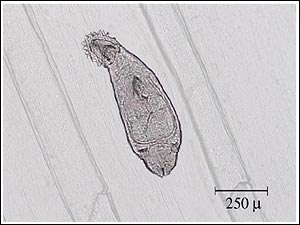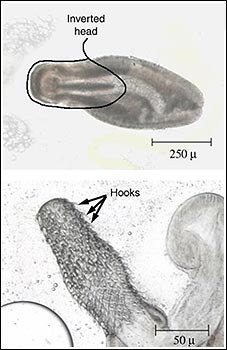

 |
||||||||||||
 |
||||||||||||
| Nematode (Roundworm) Infections in Fish | ||||||
| Page 2 of 11 | Pages: 1 . 2 . 3 . 4 . 5 . 6 . 7 . 8 . 9 . 10 . 11 | |||||
 Figure 3: Photomicrograph of a monogene (fluke) showing typical shape.
Figure 3: Photomicrograph of a monogene (fluke) showing typical shape.
 Figure 4: Photomicrograph of pentastomes showing typical shape.
Figure 4: Photomicrograph of pentastomes showing typical shape.
 Figure 5: Photomicrograph showing acanthocephalan with head inverted (top) and head everted showing typical "thorny head" with hooks (bottom).
Figure 5: Photomicrograph showing acanthocephalan with head inverted (top) and head everted showing typical "thorny head" with hooks (bottom).
Disease in Fish The severity of disease in fish will vary depending upon the life stage, species, and number of nematodes present; the age and species of infected fish; and the sites of infection. Even though adult nematodes are typically found in fish intestinal tracts, adult and other life stages can be found in almost any organ, as stated earlier, but they are most commonly present in muscle, the liver, and tissues surrounding the internal organs. Visible signs of infection may include hemorrhaging, cysts or granuloma formation (a granuloma is a reaction by immune cells in which the cells try to "wall off" some foreign bodyin this case, the worm. Granulomas formed around worms can look like little brown "rock-like" areas in the shape of the worm, but will be surrounded by a distinct clear area at their very edge), external lumps or nodules, inflammation, and necrosis (presence of dead and dying tissue). Adult nematodes in the intestinal tract damage its lining and rob the fish of nutrients, causing a "wasting" effect. During their development, many species of nematodes migrate within the body of a fish causing "worm tracks" (evidence of nematode movement through a fishs body), which are seen as "tunnels" in the tissue. Inflammation around these "worm tracks" may also be present. Extensive migration by large numbers of nematodes may cause significant physical damage to a fish. Large larval stages of some nematode species, including Eustrongylides species, may cause physical pressure on organs and abdominal distension. Juvenile fish with nematode infections are often more severely affected than adults, displaying reduced growth, wasting, or more obvious disease symptoms and mortality. However, adult fish with significant parasite loads also exhibit wasting and reduced reproductive capacity. more ... |
 |
|||||
| About Us :: Message Board :: Chat | |||||
| Library :: Photo Gallery :: Links & Resources :: Breeders & Sponsors :: Merchandise | |||||
| Website designed by: EthanCote.com | © 2001-2004, SimplyDiscus.com. All Rights Reserved. | ||||